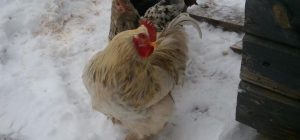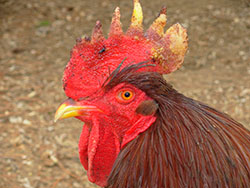Written by: Dr. Jacquie Jacob, University of Kentucky

Well-designed and maintained coops should prevent frostbite in chicken flocks, but with extremely low temperatures (single digits and below), frostbite has can become a problem. Frostbite is more likely to occur during the nighttime hours in a cold, poorly ventilated coop with damp bedding.
Birds’ combs, wattles, and possibly toes are the most vulnerable to freezing. Frostbite is most common in roosters because they typically have larger combs and wattles, but any hen with a large comb, such as a leghorn, can be vulnerable as well. The incidence of frostbite in chickens with the smaller comb types, such as pea and strawberry, is much less.

HOW CAN YOU TELL WHEN CHICKENS HAVE FROSTBITE?
Frostbite results when the fluid in tissues freezes, damaging cells to the point that the cells die. These dead areas appear off-color and will eventually blackened areas of the tips of combs or toes or the ends of the wattles. The tissues, as a result of freezing, lose blood supply, depriving the cells of oxygen. Freezing also causes physical damage to the tissues to varying degrees. The dead tissue will eventually dry up and fall off, not to regrow.
WHAT SHOULD YOU DO IF YOUR CHICKENS GET FROSTBITE?
The affected areas should be warmed slowly. Do not use direct heat, such as a hair dryer or heat lamp. Do not rub or massage the affected area. Do not trim the blackened area(s) unless it becomes infected. Removing a blackened area can expose the area beneath to frostbite as well as infection. The blackened areas actually protect the remaining comb. It is important to monitor the damaged areas for infection. With infected areas, there will be swelling, increased redness, discharge from the wound, and a bad odor. If blisters appear, leave them alone; they are filled with a “natural Band-Aid” for the damaged tissue beneath. Breaking the blisters exposes the area to infective organisms.
Frostbitten feet should be soaked in slightly warm water to slowly bring their temperature back to normal. In extreme frostbite situations, it is possible that major portions of the combs or feet will freeze. In such situations, especially if feet are affected, there is not much that can be done. If possible, limit the exposure of affected chickens to the extreme cold. Thawing and refreezing of exposed tissues will cause more damage.
Healing from frostbite can take four to six weeks. If possible, keep pen mates from pecking at frostbitten areas. Oral medications for pain are not needed; some are lethal to chickens. Chickens experience pain differently than humans and will generally appear unfazed by their injuries.
Both egg production and fertility may be affected by extremely low temperatures, whether or not frostbite is evident. The birds will recover their reproductive status as temperatures warm up.
HOW CAN YOU PREVENT FROSTBITE IN CHICKENS?
Prevention of frostbite is best. Postpone cleaning out the coop until spring. The extra layer of bedding material in the coop over winter will help insulate the building. It is important to top dress the bedding as needed throughout winter to keep it dry. Proper ventilation is necessary to prevent moisture and ammonia increases that can negatively impact the birds. Chickens generate a great deal of moisture from their breathing, feces, and water spillage. If there is condensation on windows or uninsulated walls of the coop in the morning, ventilation must be increased to keep the coop dry. Note that when the temperature is low, drinking water might freeze. Select drinkers carefully and consider using drinker warmers to prevent drinking water from freezing.
Extreme cold (sub-zero for a few days) can be reduced by a heat lamp. It is important to recognize, however, that heat lamps are a potential fire hazard. Care must be taken when placing heat lamps. Each year, chicken coops (and some attached houses) have been lost to fires caused by heat lamps. In addition, the heat lamp may disrupt chickens’ lighting schedule, which might also reduce egg production.
Some flock owners like to cover the combs and wattles with petroleum jelly. For mild freezing, petroleum jelly helps, but coop management is the real key. Flocks can do well at sub-zero temperatures if you use a deep litter system and an in-bucket water warmer, with no external heat required.

